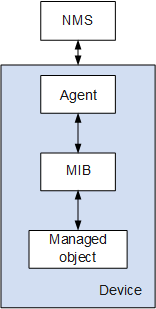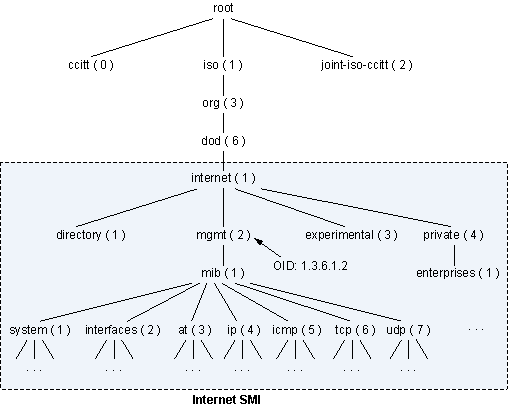SNMP Management Model
An SNMP system consists of four key components: network management station (NMS), agent, managed object, and Management Information Base (MIB).
The NMS manages network elements on a network.
Each managed device contains an agent process, MIB, and multiple managed objects. The NMS interacts with the agent on a managed device. When receiving a command from the NMS, the agent performs operations on the MIB in the managed device.
Figure 1 shows an SNMP management model.
The following describes the components in an SNMP-managed system:
NMS
The NMS is a network manager that uses SNMP to monitor and control network devices. The NMS software runs on NMS servers to implement the following functions:
- Send requests to agents on managed devices to query or modify variables.
- Receive traps from agents on managed devices to learn device status.
Agent
The agent is a process running on a managed device. The agent maintains data on the managed device, responds to requests from the NMS, and returns management data to the NMS.
- Upon receiving a request from the NMS, the agent performs the required operation on the MIB and sends the operation result to the NMS.
- If a fault or an event occurs on the managed device, the agent sends a notification containing the current device status to the NMS.
Managed object
A managed object is an object to be managed on a network device. A managed device may contain multiple managed objects, for example, a hardware component and parameters configured for the hardware or software (such as a routing protocol).
MIB
A MIB contains the variables that the managed device maintains and can be queried or set by the agent. MIB defines the attributes of the managed device, including the name, status, access rights, and data type of managed objects.
An agent can use the MIB to learn and set the device status.
An SNMP MIB uses a tree structure similar to that of the Domain Name System (DNS), with an unnamed root at the top. Figure 2 shows a part of the MIB, called an object naming tree. Each object identifier (OID) identifies a managed object; for example, a system OID is 1.3.6.1.2.1.1 and an interface OID is 1.3.6.1.2.1.2.
The OID tree facilitates information management and improves management efficiency. With the OID tree, the network administrator can query information in a batch.
When configuring the agent, you can specify the MIB objects that the NMS can access in MIB views. A MIB view is a subset of a MIB.

